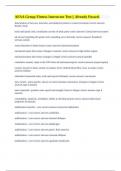AFAA Group Fitness Instructor Test || Already Passed.
Interrelation of nervous, muscular, and skeletal systems to create movement correct answers
Kinetic chain
brain and spinal cord, coordinates activity of body parts correct answers Central nervous system
all nerves branching off spinal cord, extending out to the body correct answers Peripheral
nervous system
sense distortion in body tissues correct answers mechanoreceptors
mechanoreceptor that senses changes in tension correct answers Golgi tendon organs
mechanoreceptor that senses changes in length correct answers muscle spindles
cumulative sensory input to the CNS from all mechanoreceptors correct answers proprioception
connect muscle to bone, anchor to produce force, limited blood flow, slow to repair correct
answers tendons
individual contractile units, actin and myosin filaments correct answers sarcomeres
slow twitch - more aerobic, slower to reach maximal contraction, resistant to fatigue correct
answers type I muscles
more anaerobic, produce more speed and strength, faster to fatigue correct answers type ii
muscles
extensibility, elasticity, irritability, ability to develop tension correct answers behavioral
properties of muscles
stabilization muscles - core correct answers transverse abdominus
stabilization - core correct answers multifidus
stabilization - core correct answers internal obliques
stabilization - core correct answers diaphragm
stabilization - core correct answers pelvic floor muscles
stabilization - core correct answers external obliques
stabilization - core correct answers quadrates lumborum
,stabilization - core correct answers psoas major
stabilization - core correct answers rectus abdominis
stabilization - core correct answers gluteus medius
stabilization - core correct answers adductor complex
movement - core correct answers latissimus dorsi
movement - core correct answers hip flexors
movement - core correct answers hamstring complex
movement - core correct answers quadriceps
movement - core correct answers pectoralis major
movement - core correct answers deltoids
movement - core correct answers gluteus maximus
movement- core correct answers triceps
movement - core correct answers biceps
movement - core correct answers erector spine
rectus femoris, vastus lateralis, medialis, and intermedius; knee extension; squat correct answers
quadriceps: parts, function, and exercise
semitendinosus, semaimembranosous, biceps femoris; knee flexion, hamstrings curl correct
answers hamstrings: parts, function, and exercise
plantar flexion, calf raise correct answers gastrocnemius: function and exercise
hip extension and external rotation, lunge (upward phase) correct answers gluteus maximus:
function and exercise
spinal flexion, lateral flexion, and rotation; ball crunch correct answers rectus abdominis:
function and exercise
shoulder flexion and horizontal adduction; push up correct answers pectoralis major: function
and exercise
, shoulder extension, adduction, and internal rotation; band row correct answers latissimus dorsi:
function and exercise
elbow flexion, biceps curl correct answers biceps: function and exercise
elbow extension; triceps extension correct answers triceps: function and exercise
connect bone to bone, limited blood flow, slow to repair correct answers ligaments
skull, rib cage, and vertebral column correct answers axial skeleton
bones of upper and lower extremities correct answers appendicular skeleton
movement, support, protection, blood production, mineral storage correct answers skeletal
system functions
no joint cavity or connective tissue, little to no movement (e.g., sutures of the skull) correct
answers non-synovial joint
produces synovial fluid, has joint cavity and connective tissue (gliding, condyloid, hinge, saddle,
pivot, ball-and-socket) correct answers synovial joint
synovial; no axis of rotation, slides side-to-side, back and forth (e.g., carpals of the hand) correct
answers gliding joint
synovial; condyles of one bone fit elliptical cavities of another, one plane of motion (e.g., knee)
correct answers condyloid joint
synovial; uniaxial; one plane of motion (e.g., elbow) correct answers hinge joint
synovial; one bone fits like a saddle on another; two planes of motion (sagittal, frontal) (thumbs
are only ones in body) correct answers saddle joint
synovial; one axis, transverse plane movement (e.g., radioulnar) correct answers pivot joint
synovial; most mobile, all three planes of motion (e.g., shoulder) correct answers ball-and-socket
lumbar - L1-L5
thoracic - T1-T12
cervical - C1-C7 correct answers vertebrae
reduces bone mass loss and increases bone mineral density correct answers Exercise's effect on
bones
atria (right and left), ventricles (right and left), sinoatrial node, arteries, veins, stroke volume,
heart rate, functions of blood, respiratory pump correct answers Structures of the heart




